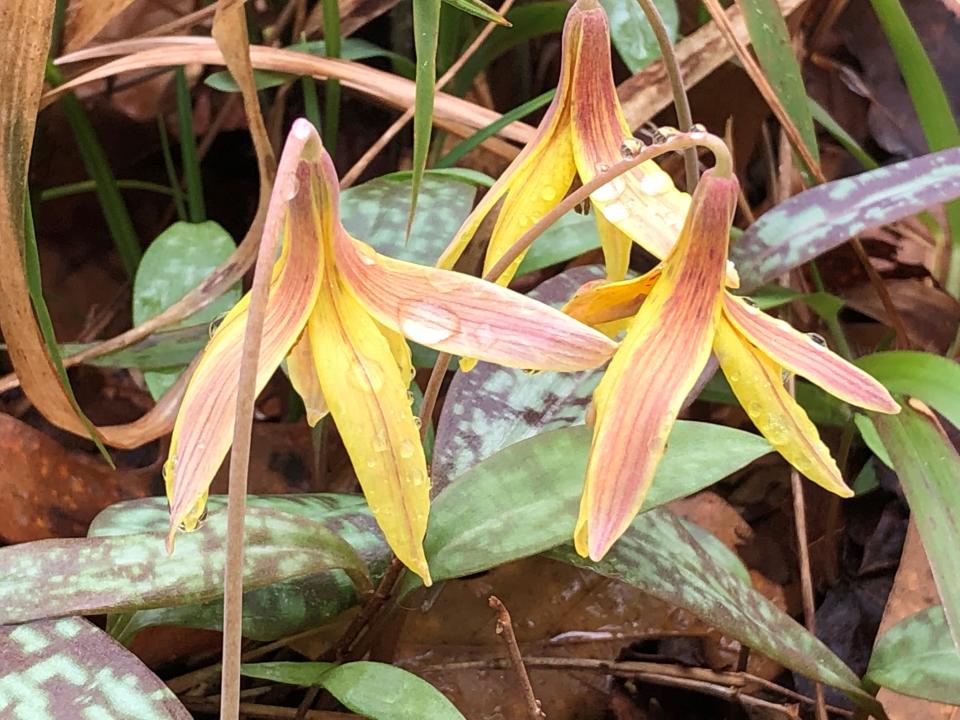Woodland lily is one of spring's first bloomers | Mystery Plant
Spring is here and this wildflower is proof. It is one of the earliest blooming woodland species we have. And, I think you will agree, it’s one of the prettiest.
Folks, I’m telling you that this spring seems to be one of the best in recent history, as far as numbers of flowers popping out all at once. Make sure that you take some time, soon, to investigate the wildflowers of your own particular region!

Trout lily, Fawn lily, Erythronium umbilicatum, is a perennial, North American member of the lily family, and it belongs to a group (a genus) of about 25 species, most of which are on our side of the pond; there are a few species that are European. All of them have a deeply buried, slender bulb, and among the species is quite a variety of flower colors.
Astronomy:March skies brighten with spring equinox, Daylight Saving Time | The Sky Guy
Lawn care:This month, let the weeds be free with No Mow March | Mark Tancig
Wildflower:Magic carpet of flowers will be blooming soon at Wolf Creek Preserve near Cairo
Our Mystery Plant produces two leaves at maturity. The leaves are strongly mottled, green, with a sort of purplish “liver” color. This plant would be perfect for a botany class, especially for a discussion of flower parts. A slender flower stalk bears a single flower, and there are six parts of the yellow perianth, that is, three sepals and three petals, beautifully and daintily striped.
Within the flower are six stamens, each consisting of a long, slender filament, and at the end of each, a pollen-filled anther. The anthers are generally reddish or purplish. The ovary at the bottom of the flower doesn’t have any stamens, sepals or petals attached to it, so we say that it is a “superior” ovary.
After blooming, the ovary matures into a plump seed pod. While it is developing, this seed pod becomes heavier, flopping down all the way to the ground, ultimately splitting open and letting the seeds out.
You can find this species widely distributed from West Virginia and Maryland down to Alabama, and just barely into northern Florida.
In the Carolinas it is most commonly seen in the piedmont and mountain counties. It is frequently seen in patches in rich woods, often along creek banks, well before the trees above them have unfolded their leaves. The plants don't stay above the ground very long after they have produced their fruits and seeds: by summer time, all the plants have disappeared.
This early spring-blooming "strategy" makes sense, because when the leaves on the trees are fully expanded, there is much less available light on the forest floor. Seedlings or young plants tend to have only one leaf, and these young plants typically don't bloom.
If you find a patch of this splendid wildflower, try to resist the temptation of digging some up for your garden. The bulbs tend to be very deep, and are easily injured if disturbed. They can be grown in your garden from seed…although the process takes several years before blooming occurs.
In the case that you are interested in growing native wildflowers, consider acquiring them from responsible growers and propagators. Your state’s native plant society ought to have such a list. Learn more by visiting the Florida Native Plant Society site at fnps.org.
John Nelson is the retired curator of the Herbarium at the University of South Carolina, in the Department of Biological Sciences. As a public service, the Herbarium offers free plant identifications. For more information, visit www.herbarium.org or email johnbnelson@sc.rr.com.
This article originally appeared on Tallahassee Democrat: Trout lily is one of spring's earliest bloomers | Mystery Plant

